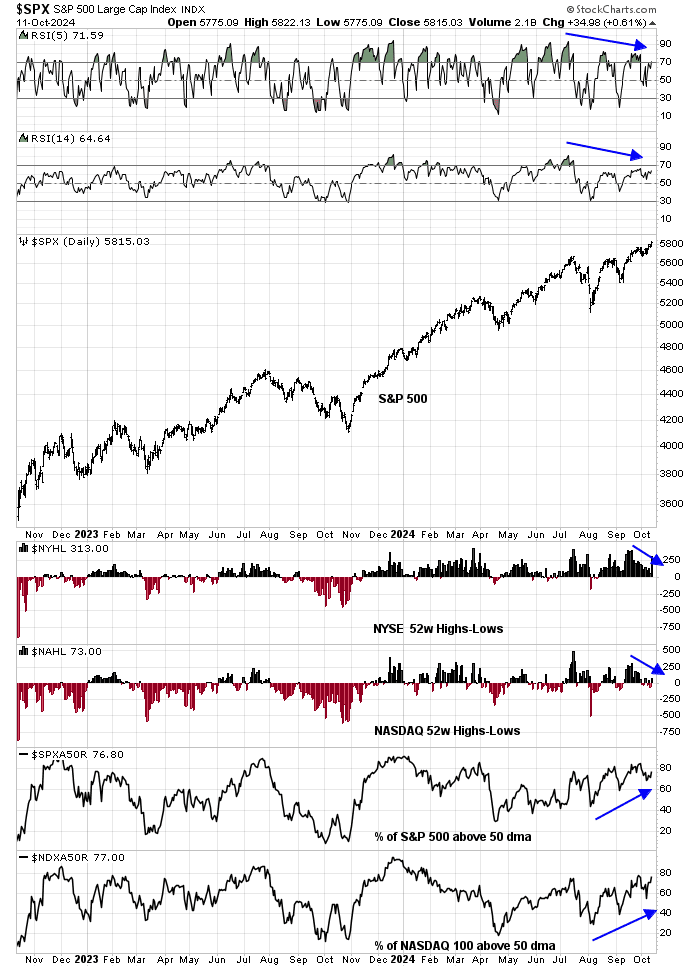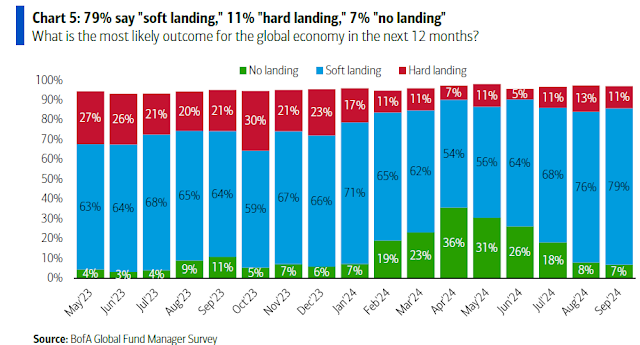Mario Draghi is known as the ECB President who said that he would do “whatever it takes” to save the euro. Now, his
report on European Union competitiveness is designed to save the EU, and it’s caused quite a stir. Draghi identified the issues of EU competitiveness as poor productivity, caused by fragmentation of industrial policy along national lines, and a lack of co-ordination and focus across policy lines, such as fiscal, trade and foreign policies.
As a solution, Draghi is calling for a re-focus of industrial policy and a minimum annual investment of “€750 to €800 billion…based on the latest Commission estimates, corresponding to 4.4-4.7% of EU GDP in 2023. For comparison, investment under the Marshall Plan between 1948–51 was equivalent to 1–2% of EU GDP”. The investment would have to be financed mainly by euro area debt.
If implemented, the Draghi Plan will put the eurozone on the road to fiscal dominance. Currently, euro area debt averages 88.6% of GDP, which is just short of the 90% guideline specified by Reinhart & Rogoff when a sovereign becomes at risk of significant and prolonged reductions in economic growth. By comparison, the U.S. debt to GDP ratio stands at 121%. However, eurozone countries have arguably less fiscal room as member states can’t print their own currency and must rely on the European Central Bank.

This will cement developed economies’ path to fiscal dominance. Investors will need to prepare accordingly.
Prescriptions for EU competitiveness
The Draghi Report written for the European Commission offers a cleared-eyed assessment of the challenges to EU growth. Compared to the U.S., EU productivity peaked at about the time of the introduction of the euro. Draghi warned in an Economist guest column that “Europe’s population is set to decline and it will have to lean more on productivity to grow. If the EU were to maintain its average productivity-growth rate since 2015, it would only be enough to keep GDP constant until around 2050.”
Draghi also highlighted lagging productive investment against the U.S. as a particular problem.
Draghi identifies the U.S. and China as the EU’s main competitors. One of the key barriers to competitiveness has been the fragmentation of R&D funding. While the level of public support for R&D is similar to the U.S., most of the funding has come from national governments, with a focus on national champions instead of a pan-European scale. By contrast, America’s DARPA programs haven’t suffered from similar constraints and they have been far more successful in sparking innovation.
Most Member States cannot achieve the necessary scale to deliver world-leading research and technological infrastructures…By contrast, the examples of CERN and the European High-Performance Computing Joint Undertaking (EuroHPC) showcase the importance of coordination when developing large R&I infrastructure projects.
To rectify poor European productivity, he proposes three main steps. First, close the innovation gap with the U.S. The EU needs a pan-European industrial policy to encourage innovation and commercialization of technologies. In particular, “a weak tech sector will not only rob it of the growth opportunities of the coming AI revolution. It will also hinder innovation in a wide range of adjacent sectors—such as pharmaceuticals, cars and defence—where integrating AI into operations will be critical for the EU to remain competitive”.
In particular, replace the fragmented system of regulation with a pan-European approach, as “the lack of a true Single Market also prevents enough companies in the wider economy from reaching sufficient size to accelerate adoption of advanced technologies”.
Second, Draghi proposed combining decarbonization with competitiveness. As Europe has been one of the global proponents of the green revolution, the EU should be able to lever its competitive advantage in this sector. By contrast, Europe largely missed out on the digital and internet revolution.
Draghi also proposes defence and space as a source of competitiveness. European countries are short of the 2% of GDP NATO target on defence spending. The European defence and space industry is highly fragmented and lacks standardization, which hinders scale and inter-operability. In addition, dependencies on raw materials and crucial technologies (read: China) leaves it vulnerable to coercion. The solution is greater European integration. As well, the EU needs a common foreign and industrial policy to increase security and reduce dependencies.
Financing all of these initiatives will require a variety of subsidies [emphasis added]:
The European Commission and the IMF’s Research Department have simulated scenarios of a sustained EU investment push of around 5% of GDP, using their multi-country models…Historically in Europe, around four-fifths of productive investment has been undertaken by the private sector, and the remaining one-fifth by the public sector. Delivering private investment of around 4% of GDP through market financing alone would require a reduction in the private cost of capital – by approximately 250 basis points in the European Commission model. Although improved capital market efficiency (e.g. through the completion of the Capital Markets Union) is expected to reduce private financing costs, the reduction will likely be substantially smaller. Fiscal incentives to unlock private investment therefore appear necessary to finance the investment plan, in addition to direct government investment.
Draghi pointed out that “the issuance of a common safe asset [EU wide bond financing] would make the CMU much easier to achieve and more complete”. The immediate German reaction to the proposal has been “Nein. We are not paying for the rest of Europe.” But the Draghi proposal is not addressed to the current German government, but to the European Commission’s next budget, which will be dependent on the next German government.
Europe being Europe, I expect that we will see the usual form of European theater in the coming months, with a compromise solution being hammered out and Europe on the path to fiscal dominance as its debt load grows.
Fiscal dominance in America
Across the Atlantic, the U.S. debt situation is similarly challenging when compared to Europe. Regardless of who wins the election in November, U.S. federal debt is expected to rise. Neither side has proposed significant fiscal tightening measures to reduce the deficit. The latest estimates of the Congressional Budget Office estimates that debt to GDP will rise to 122% by 2034 from 121% today.
This will eventually constrain monetary policy, as raising rates to contain inflation will force the federal government to devote an increasing portion of its budget and tax revenue to debt service costs. We have seen what has happened in Japan, where the BoJ owns not only a substantial portion of outstanding JGBs, but also Japanese equities in order to support financial and economic stability.
To put the evolution of U.S. debt into context, federal government debt (red line) had been relatively stable and under control until the GFC, when it shot upward in response to the crisis. It took an additional lurch upward in response to the COVID Crisis. By contrast, corporate debt (blue line) had been relatively stable since 2000.
In other words, much of the increase in federal government debt is primarily attributable to a fiscal response to major crises. It was the U.S. Treasury that put its credit and balance sheet on the line to shield the banking sector during the GFC, and to rescue the U.S. economy from a repeat of the Great Depression during the COVID Crisis.
That doesn’t mean that fiscal intervention isn’t without cost. As U.S. federal finances become increasingly strained in the coming years, investors should expect the term premium, or the premium demanded by investors to hold a long-dated Treasury (black line, right scale), to rise.
Investment implications
However, investors should expect substantial downward pressure on the USD. That’s because other developed market sovereigns will be in a similar position.
I would instead expect the pressure to appear in the pricing of hard assets against paper assets. The gold to S&P 500 ratio is making a multi-year saucer-shaped bottom. It has substantial potential to rise, as the 200 dma hasn’t even turned up yet.
Tactically, I would wait for definitive confirmation of a fresh gold bull from gold priced in other currencies. While Gold in USD, in EUR, and CNY all recently reached all-time highs, though the rise in the Chinese Yuan terms is not surprising due to PBOC buying for geopolitical reasons. On the other hand, gold in JPY is still consolidating its gains.
As a reminder, the measured objective on a monthly point and figure chart of gold is about $4,400, which can be regarded as a rough approximation of upside potential on a 4–8-year time frame.
In conclusion, the sovereign debt levels of major developed economies are well on the path to fiscal dominance, underpinned by the U.S. fiscal trajectory. Mario Draghi’s proposals for European competitiveness also highlighted a need for debt-financed investments that will also substantially raise EU debt to GDP ratios. Investors should expect a regime shift toward higher term premiums on bonds and from paper assets to hard assets in the coming years.




















































































































































































